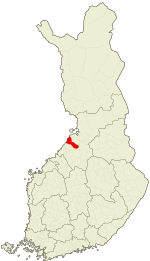Raahe
| Raahe | ||
|---|---|---|
| Town | ||
| Raahen kaupunki | ||
|
Raahe Church and statue of Per Brahe | ||
| ||
 Location of Raahe in Finland | ||
| Coordinates: 64°41′N 024°28′E / 64.683°N 24.467°ECoordinates: 64°41′N 024°28′E / 64.683°N 24.467°E | ||
| Country | Finland | |
| Region | Northern Ostrobothnia | |
| Sub-region | Raahe sub-region | |
| Charter | 1649 | |
| Government | ||
| • City manager | Kari Karjalainen | |
| Area (2011-01-01)[1] | ||
| • Total | 1,399.26 km2 (540.26 sq mi) | |
| • Land | 528.49 km2 (204.05 sq mi) | |
| • Water | 870.77 km2 (336.21 sq mi) | |
| Area rank | 77th largest in Finland | |
| Population (2015-06-30)[2] | ||
| • Total | 25,342 | |
| • Rank | 46th largest in Finland | |
| • Density | 47.95/km2 (124.2/sq mi) | |
| Population by native language[3] | ||
| • Finnish | 98.5% (official) | |
| • Swedish | 0.1% | |
| • Others | 1.4% | |
| Population by age[4] | ||
| • 0 to 14 | 19.2% | |
| • 15 to 64 | 66.9% | |
| • 65 or older | 13.9% | |
| Time zone | EET (UTC+2) | |
| • Summer (DST) | EEST (UTC+3) | |
| Municipal tax rate[5] | 20% | |
| Website | www.raahe.fi | |

Raahe (Swedish: Brahestad) is a town and municipality of Finland. Founded by Swedish statesman and Governor General of Finland Count Per Brahe the younger in 1649, it is one of 10 historic wooden towns (or town centers) remaining in Finland. Examples of other Finnish historic wooden towns are Kaskinen (Kaskö), Old Rauma, Porvoo (Borgå), Jakobstad (Pietarsaari), and Vaasa (Vasa). After a devastating fire in 1810, Raahe was rebuilt adhering to new design principles which minimized the risk of fire and enlarged some civic spaces. Old Raahe is noted for its Renaissance-inspired rectilinear town plan featuring an unusual central-square (called Pekkatori) with closed corners.
Raahe is located on the northern shores of the Gulf of Bothnia in the Northern Ostrobothnia region. The municipality has a population of 25,342 (June 30, 2015)[2] and covers an area of 1,399.26 square kilometres (540.26 sq mi) of which 870.77 km2 (336.21 sq mi) is water.[1] The population density is 47.95/km2 (124.2/sq mi). Historically an agricultural and maritime region, Ostrobothnia supplied the largest number of immigrants from Finland to the US and other countries such as Canada and Australia during the great migration of the late 19th and early 20th centuries.
Founded as a Swedish- and Finnish-speaking town, the municipality is now unilingually Finnish.
Economy
Raahe was granted staple port rights in 1791, and was traditionally a harbor town. With industrialization, Raahe was reinvented as a steel and heavy industry city, and has further developed with engineering services, ICT and software production. Raahe is known for steel, heavy machinery, engineering works, shipping and ICT. The Rautaruukki steel mill, which up to the 1980s was the largest single industrial site in the Nordic countries, is located in Raahe. The mill produces steel plate, coil and sheeting and semifinished products for the engineering works.
Traditionally, Raahe was a port city. In the late Age of Sail, 1850s and on, shipping companies in Raahe owned Finland's largest fleet of sailing vessels, 60 in total at their height. Currently, the port of Raahe is the sixth busiest port in the country, with 700 ships visiting each year. Cargo that is transported through the port includes raw materials and loose cargo, steel, lumber, containers and contract-shipped goods.
With the steel industry, Raahe has grown into the third largest city in the ex-Oulu province, after Oulu and Kajaani. Like Oulu, the city promotes the ICT business, with the help of the steel industry (ProMetal and Steelpolis) and ICT industry (Softpolis) business incubators/business parks.
The municipal tax rate is 19.75%. In 2007, the structure of the economy was as follows: agriculture and forestry 1%, construction 6%, manufacturing 43%, and retail, services and public services 50%. The sub-region includes the municipalities of Pyhäjoki and Siikajoki.
International relations
Twin towns — Sister cities
Raahe is twinned with:
 Skellefteå, Sweden, since 1946
Skellefteå, Sweden, since 1946 Løgstør, Denmark, since 1946
Løgstør, Denmark, since 1946 Bergen, Norway, since 1946
Bergen, Norway, since 1946 Cherepovets, Russia, since 1968
Cherepovets, Russia, since 1968 Košice, Slovakia, since 1987[6]
Košice, Slovakia, since 1987[6] Vårgårda, Sweden
Vårgårda, Sweden Kullamaa, Estonia
Kullamaa, Estonia
References
- Notes
- 1 2 "Area by municipality as of 1 January 2011" (PDF) (in Finnish and Swedish). Land Survey of Finland. Retrieved 9 March 2011.
- 1 2 "VÄESTÖTIETOJÄRJESTELMÄ REKISTERITILANNE 30.06.2015" (in Finnish and Swedish). Population Register Center of Finland. Retrieved 17 July 2015.
- ↑ "Population according to language and the number of foreigners and land area km2 by area as of 31 December 2008". Statistics Finland's PX-Web databases. Statistics Finland. Retrieved 29 March 2009.
- ↑ "Population according to age and gender by area as of 31 December 2008". Statistics Finland's PX-Web databases. Statistics Finland. Retrieved 28 April 2009.
- ↑ "List of municipal and parish tax rates in 2011". Tax Administration of Finland. 29 November 2010. Retrieved 13 March 2011.
- ↑ "Twin cities of the City of Kosice". Magistrát mesta Košice, Tr. Retrieved 2013-07-27.
External links
-
 Media related to Raahe at Wikimedia Commons
Media related to Raahe at Wikimedia Commons -
 Raahe travel guide from Wikivoyage
Raahe travel guide from Wikivoyage - Town of Raahe – Official site
- Old Raahe historical information in English, Finnish, German, and Swedish
- Finnish Institute of Migration English pages with historical information and databases
- Genealogical Society of Finland pages in English
| |||||||||||||||||


